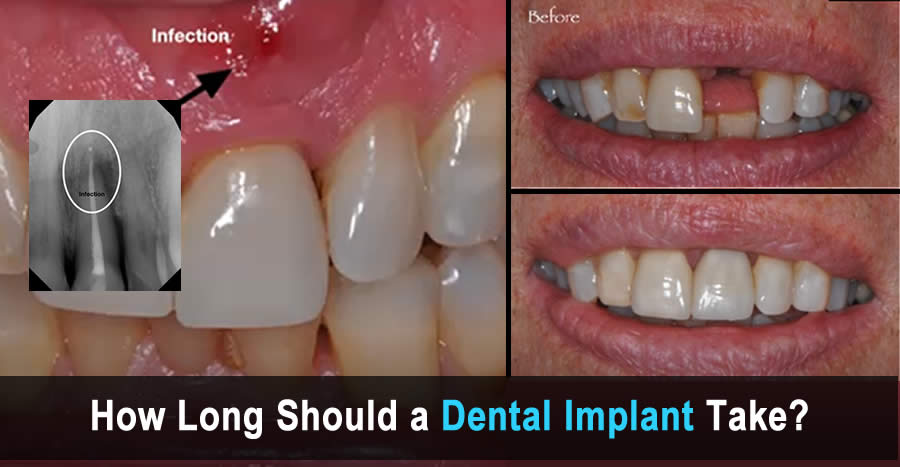
The journey of dental implants spans several months, encompassing various stages from consultation to final placement. On average, the process takes 3 to 6 months, including the integration of the implant with the jawbone, typically lasting 3 to 4 months. Additional time is needed for gum healing and crown placement. Each individual’s case may vary, so consulting with a dentist is essential to determine a personalized timeline. While the process requires patience, the eventual outcome of restored functionality and aesthetics makes the wait worthwhile, ensuring a confident smile for years to come.

How Long for Dental Implant?
Dental implants are a popular and effective solution for replacing missing teeth. They provide a long-lasting and natural-looking solution that can significantly improve a person’s oral health and quality of life. However, many people wonder how long the dental implant process takes from start to finish. In this article, we will explore the timeline of a dental implant procedure and discuss the factors that can influence the length of the process.
Understanding the Dental Implant Process
The dental implant process involves multiple stages, starting with an initial consultation to assess oral health and suitability for implants. Next is the surgical placement of implant posts into the jawbone, followed by a healing period of several months for osseointegration. Factors like oral health issues or the need for preparatory procedures such as bone grafting can lengthen the process. Addressing these issues may require additional treatment and healing time, impacting the overall timeline of the dental implant process. Consultation with a dentist is crucial for evaluating individual factors and determining the optimal treatment plan.
The Timeline of a Dental Implant Procedure
The timeline of a dental implant procedure can vary from patient to patient, depending on their individual circumstances. However, a rough estimate of the timeline is as follows:
1. Initial Consultation: This stage typically takes one to two visits, during which the dentist evaluates the patient’s oral health and discusses the treatment plan.
2. Preparatory Procedures (if needed): If the patient requires any additional treatments, such as bone grafting or sinus lifts, these procedures may add several months to the overall timeline.
3. Implant Placement: The surgical placement of the implant posts usually takes one to two hours per implant. The number of implants required will depend on the patient’s specific needs.
4. Osseointegration: This is the healing period during which the implants fuse with the jawbone. It typically takes three to six months, although some cases may require longer healing times.
5. Abutment Placement: After osseointegration is complete, the abutments (connector pieces) are attached to the implants. This step is usually performed under local anesthesia and takes about one hour.
6. Final Restoration: The final step is the placement of the dental crown or prosthetic tooth onto the abutments. This step typically takes one to two visits and is customized to match the patient’s natural teeth.
Benefits of Dental Implants
Dental implants offer numerous benefits compared to other tooth replacement options. They provide a permanent solution that looks, feels, and functions like natural teeth. Implants also help preserve the jawbone and prevent bone loss, which can occur with missing teeth. Additionally, dental implants do not require any special maintenance and can be cared for just like natural teeth, including brushing, flossing, and regular dental check-ups.
Conclusion
In conclusion, the timeline of a dental implant procedure can vary depending on various factors, such as the patient’s oral health, the need for additional procedures, and the healing process. It is essential to consult with a qualified dentist or oral surgeon to determine an accurate timeline for your specific case. With proper care and maintenance, dental implants can provide a long-lasting and functional solution for replacing missing teeth and improving overall oral health.
Key Takeaways: How Long for Dental Implant?
- It takes around 3 to 6 months for a dental implant to fully heal and integrate with the jaw bone.
- Every patient is different, so the time for dental implant healing may vary.
- Good oral hygiene is crucial during the healing process to ensure successful implant integration.
- Regular check-ups with your dentist are necessary to monitor the progress of the implant healing.
- Following the post-operative instructions provided by your dentist can help speed up the healing process.
Frequently Asked Questions
How long does it take to get a dental implant?
Getting a dental implant is a multi-step process that involves several stages. The length of time it takes to complete the entire procedure can vary depending on individual circumstances and the specific treatment plan. On average, the process can take anywhere from several months to over a year.
During the first stage, the implant is surgically placed into the jawbone, which requires time for the bone to heal and integrate with the implant. This healing process, known as osseointegration, can take around 3 to 6 months. Once the implant has fused with the bone, the next stage involves attaching an abutment and crown, which can be done within a few weeks.
Are there any factors that can affect the duration of a dental implant procedure?
Yes, there are several factors that can influence how long it takes to complete a dental implant procedure. These factors include:
1. Bone quality and density: If a patient has insufficient bone density or poor bone quality, additional procedures such as bone grafting may be necessary, which can extend the overall treatment time.
2. Oral health: If a patient has periodontal disease or other oral health issues, these conditions will need to be addressed before the implant procedure can proceed, which may delay the timeline.
3. Healing capacity: Each individual’s healing process may vary, and some patients may require more time for their body to heal and for the implant to integrate with the bone.
What are the different stages involved in a dental implant procedure?
A dental implant procedure typically involves several stages:
1. Initial consultation and examination: The dentist will assess the patient’s oral health, take X-rays, and create a treatment plan tailored to their specific needs.
2. Implant placement: The implant is surgically placed into the jawbone. After this step, a healing period is required for osseointegration to occur.
3. Abutment placement: Once the implant has integrated with the bone, an abutment is attached to the implant, which will serve as a connector for the final restoration.
4. Crown placement: The final step involves attaching a custom-made dental crown to the abutment, creating a natural-looking and functional replacement tooth.
Can the dental implant process be expedited?
While the dental implant process generally requires sufficient time for proper healing and integration, there are certain techniques and technologies that can help expedite the overall treatment time. For example, immediate loading implants allow for the placement of a temporary crown on the same day as the implant surgery, reducing the waiting time for a permanent restoration. However, it is important to consult with your dentist to determine if you are a suitable candidate for expedited implant procedures.
It is worth noting that rushing the dental implant process can potentially compromise the success and longevity of the implant. It is crucial to prioritize proper healing and follow your dentist’s recommendations to ensure the best possible outcome.
What can I do to ensure a successful dental implant procedure?
To increase the chances of a successful dental implant procedure, it is important to:
1. Maintain good oral hygiene: Follow your dentist’s instructions for oral care, including regular brushing, flossing, and dental check-ups.
2. Avoid smoking: Smoking can significantly impair the healing process and increase the risk of implant failure. Quitting smoking before and after the procedure is highly recommended.
3. Follow post-operative instructions: After the implant placement, carefully follow any post-operative instructions provided by your dentist, including dietary restrictions, medication usage, and activity limitations.
4. Attend regular follow-up appointments: Regular check-ups with your dentist will allow them to monitor the progress of your implant and address any potential issues before they become major problems.
By taking these measures, you can help ensure a successful dental implant procedure and enjoy the benefits of a restored smile for years to come.
Final Summary: So, How Long Does It Take for a Dental Implant?
The duration of the dental implant process varies based on factors like oral health and complexity. On average, it takes several months to a year. The process includes examination, surgery, healing, and attachment of the artificial tooth. Despite the time commitment, the outcome—a functional and long-lasting tooth replacement—makes it worthwhile.
Call or Book appointment online
:Ace Dental Care Alpharetta office: 678-562-1555 - Book Now
Ace Dental Care Norcross office: 770-806-1255 - Book Now
Disclaimer
This blog post was generated by artificial intelligence. The content of this post may not be accurate or complete, and should not be relied upon as a substitute for professional advice. If you have any questions about the content of this post, please contact us.
We are constantly working to improve the accuracy and quality of our AI-generated content. However, there may still be errors or inaccuracies. We apologize for any inconvenience this may cause.





